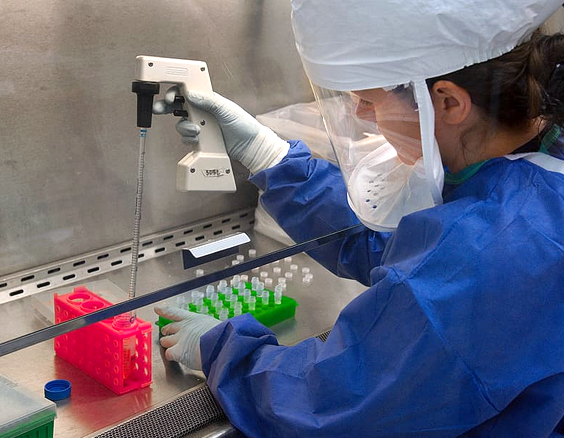This article is part of World War “V”: The COVID-19 Pandemic, a collection of all CNS COVID-19-related articles.
June 1, 2020
Richard Pilch and Miles Pomper
The following is an excerpt of an analysis published by the War on the Rocks.
Over the past several weeks, U.S. President Donald Trump and Secretary of State Mike Pompeo have repeatedly suggested that the virus that causes COVID-19 may have leaked from a biological laboratory in China rather than naturally spreading from animal to human hosts. While there is currently little evidence to support this hypothesis, a broader analysis of international laboratory biosafety in the context of global health security is long overdue. How can the global community ensure that laboratories act safely when working with dangerous infectious diseases like COVID-19?

Researcher in safety gear, Source: Pxfuel.com
Such laboratories are necessary to understand and address infectious diseases. However, the reality is that these laboratories pose a biosafety risk, whether they’re in China, the United States, or anywhere else. Laboratory-acquired infections happen — one review identified more than 1,000 of them over a 25-year period, or approaching one infection per week on average. The most commonly identified causes are mishandled needlesticks or sharps, animal handling, spills or splashes, and accidental ingestion, but these account for only a portion of all laboratory-acquired infections. Inadvertent aerosols are suspected to cause a considerable proportion of the remaining infections, but in many cases the actual source of infection is never identified. In cases of contagious disease, where infected laboratory workers can then transmit the infecting agent to persons outside the laboratory, community outbreaks or even global pandemics can occur.
The Four-Step Plan
While we can mathematically quantify the corresponding risk to laboratory workers, extending that risk assessment to the local and global community poses numerous challenges. First, we need a full account of laboratories by location. Second, we need to know what specific activities each laboratory is performing, and with what specific biological agents. Third, we need to know what corresponding safety measures are in place and how reliable they are. And fourth, we need to know details of the surrounding community, including population demographics, density, mobility, and so on. None of this information is routinely collected at the international level; moreover, there is no international body, process, or standard to collect it.
To address this critical gap, the United States should work with the World Health Organization to establish an international safety regime for laboratories. Despite recent critiques of the organization’s handling of COVID-19 by the Trump administration, including its April announcement that the United States would halt funding to it and a May declaration at the 73rd World Health Assembly that it had “failed at its core mission,” it remains a linchpin in such efforts. The World Health Organization has successfully implemented similar international standards for infectious disease reporting and corresponding capacities, is a recognized authority on laboratory biosafety, and maintains the close working relationships with all governments needed to establish global scientific governance.
Continue reading at War on the Rocks.
